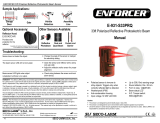Page is loading ...

ENFORCER
®
Request-to-Exit Plate with Pneumatic Timer
4 SECO
SECOSECO
SECO-
--
-LAR
LARLAR
LARM
MM
M
®
U.S.A., Inc
Also Available from SECO-LARM:
Maglocks
E-941SA-600
(shown)
Electronic Door
Strikes
SK-990AQ
(shown)
Digital Keypads
SK-2323-SDQ
(shown)
No
-
Touch Exit Plates
SD-9263-KSVQ
(shown)
Central Receiver
SK-910RC4Q
Weatherproof
Transmitter Box
SK-919TPWFEUQ
Wireless Reflective
Beam Sensor
E-931-S45T19Q
Wireless Exit Plates
SD-8202GT-PEQ
(shown)
WARRANTY This SECO-LARM product is warranted against defects in material and
workmanship while used in normal service for a period of one (1) year from the date of sale to
the original consumer customer. SECO-LARM’s obligation is limited to the repair or replacement
of any defective part if the unit is returned, transportation prepaid, to SECO-LARM.
This Warranty is void if damage is caused by or attributed to acts of God, physical or electrical
misuse or abuse, neglect, repair, or alteration, improper or abnormal usage, or faulty installation,
or if for any other reason SECO-LARM determines that such equipment is not operating properly
as a result of causes other than defects in material and workmanship.
The sole obligation of SECO-LARM, and the purchaser’s exclusive remedy, shall be limited to
replacement or repair only, at SECO-LARM’s option. In no event shall SECO-LARM be liable for
any special, collateral, incidental, or consequential personal or property damages of any kind to
the purchaser or anyone else.
NOTICE: The information and specifications printed in this manual are current at the time of
publication. However, the SECO-LARM policy is one of continual development and improvement.
For this reason, SECO-LARM reserves the right to change specifications without notice.
SECO-LARM is also not responsible for misprints or typographical errors.
Copyright © 2011 SECO-LARM U.S.A., Inc. All rights reserved. This material may not be
reproduced or copied, in whole or in part, without the written permission of SECO-LARM.
SECO
SECOSECO
SECO-
--
-LARM
LARMLARM
LARM
®
U.S.A., Inc.
16842 Millikan Avenue, Irvine, CA 92606 Website: www.seco-larm.com
Tel: 800-662-0800 / 949-261-2999 Fax: 949-261-7326 E-mail: sales@seco-larm.com
PITSW1
MiSD-7xx3-xSP-1101.docx
Order Part #763
-
1
72
-
2
%
Request-to-Exit Plate
with Pneumatic Timer
Manual
Mushroom Cap Pushbutton
Green pushbutton
SD-7113-GSP
SD-7213-GSP
Slimline Plate
Single Gang Plate
Red pushbutton
SD-7113-RSP
SD-7213-RSP
Slimline Plate
Single Gang Plate
Standard Button with Guard Ring
SD-7173-SSP
SD-7273-SSP
Slimline Plate
Single Gang Plate
No
Power
Required

R
®
Request-to-Exit Plate with Pneumatic Timer
2 SECO
SECOSECO
SECO-
--
-LAR
LARLAR
LARM
MM
M
®
U.S.A., Inc
Introduction:
The ENFORCER SD-7X13-XSP series Request-to-Exit Plates with Pneumatic Timer is ideal for
applications where providing power to a timer is inconvenient, hazardous or not conforming with
local codes and ordinances. Adjusting the time is easy via a timing screw and can be performed
on the spot without tools.
Features:
•
Pneumatic timer has these special features:
Conforms to NFPA 101 Fire Codes for
non-electrical breaking of contact.
Functions entirely without electricity.
Excellent for installs where supplying
additional timer power is inconvenient.
Reliable American made pneumatic
components.
•
Stainless
steel single
gang or slimline plate.
•
English “EXIT” and Spanish “SALIDA”
printed on plate.
•
Timer adjustable for 1~60 second.
•
Green or red mushroom cap pushbutton.
(SD-7113-xSP / SD-7213-xSP)
hi
•
Standard button with guard ring.
(SD-7173-SSP / SD-7273-SSP)
hi
Specifications:
Timer
Pneumatic: 1~60 s
*
Switching capacity
5A@125VAC
Operating temperature
32°~131
° F
(0°~55° C)
Wiring
Red
2x
N.C. #18 AWG 9
”
(2
30
mm)
White
2x
N.O. #18 AWG
9
”
(2
30
mm)
Dimensions
(height x width)
Single gang
4
1
/
2
”
x2
3
/
4
”
(11
5
x
70
mm)
Slimline
4
1
/
2
”
x
1
1
/
2
”
(11
5
x
3
9
mm)
Dimensions
(depth)
SD
-
7
x
13
-
GSP
(Mushroom Pushbutton)
3
1
/
2
” (88mm)
SD
-
7
x
73
-
SSP
(Guard Ring)
2” (50mm)
*Note: Time is precise to within ±10% for constant temperature and may change according to environmental factors.
Dimensions:
1
1
/
2
”
(39mm)
2
3
/
4
”
(70mm)
2”
(50mm)
3
1
/
2
”
(88mm)
4
1
/
2
”
(115mm)
SD
-
7
x
13
-
x
SP
SD
-
7
x
7
3
-
S
SP
SD
-
7
2
13
-
GSP
Shown
SD
-
7
1
13
-
GSP
Shown
ENFORCER
®
Request-to-Exit Plate with Pneumatic Timer
SECO
SECOSECO
SECO-
--
-LAR
LARLAR
LARM
MM
M
®
U.S.A., Inc 3
Power Supply
RTE Plate w/ Pneumatic Timer
Electronic Lock
Use ENFORCER Request
to Exit Plates with Pneumatic
Timer anywhere zero-spark
switching is required.
For N.C. (fail safe) operation,
connect the red wires.
EAP-5D1Q
Access Control
Power Supply
ENFORCER Series
Electromagnetic Lock
Installation:
1. Find a suitable location for the pneumatic request-to-exit plate.
2. The pneumatic request-to-exit plate can be either surface mounted or flush mounted.
3. Wire the request-to-exit plate as described below under Wiring.
4. Adjust the timer as described below under Adjusting the Timer.
5. Test the function of the exit plate and timer, as well as the timer delay.
6. Mount the request-to-exit plate in a back-box or other suitable housing.
Wiring
1. For N.C. operation (fail safe), connect the red wires to the electronic lock or other device.
2. For N.O. operation (fail secure), connect the white wires to the electronic lock or other device.
Adjusting the Timer:
1. Locate the timing screw as shown in the figure to the right.
2. Using fingers or a flat screw driver, gently turn the timing screw
as so:
a. Increase delay: Tighten the screw clockwise
b. Decrease delay: Loosen the screw counterclockwise
Note: Do not over tighten or over loosen the timing screw. If screw
becomes very loose, retighten it until it feels secure.
3. The minimum delay time is approximately 1 second, and the
maximum delay time is approximately 60 seconds. Use a stop
watch to adjust the time to suit the application.
Example Installation:
(
SD
-
7
1
7
3
-
S
SP
Shown)
Timing Screw
Timer Assembly
/









